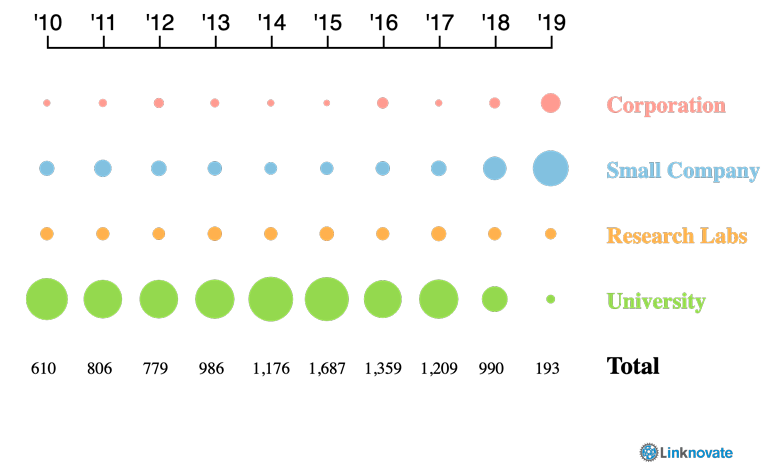It was not long ago when chemical clarification, granular media filtration, and chlorination were the only processes used for water treatment. But, as the availability and quality of water resources worldwide decreases, demand for new, more efficient water treatment systems rises.
During the last two decades we have seen how new and alternative water technologies have been implemented, especially those based on membrane filtration, ozonation, and biological filtration.
For the years to come, we have used Linknovate discovery platform to identify and analyze the three most promising trends and technologies in industrial water treatment poised to mark research and innovation efforts.
1. Internet of Things for Industrial Water Treatment
When applied to water management and treatment, Internet of Things (IoT) technology has promising applications for reducing unnecessary costs while optimizing daily processes for improving overall management.
IoT can play a key role in leak detection and send automated notifications and alerts to the control panel, so actions can be taken immediately.
- Evolution of IoT for Water Treatment
As we can observe in the graph below, improving water management processes by using sensors and Internet of Things technology is a trending topic right at the moment that is hyping. It definitely is the moment for the industry to start being active and implement this technology as a differential growth and innovation factor.
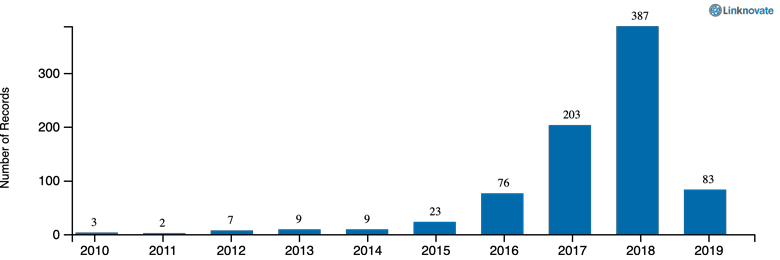
- Top 10 Organizations Worldwide applying IoT to Water Treatment
The top 10 of the most active organizations worldwide applying IoT technology to water management is all comprised by Corporations: eight from the United States, one from Germany (Siemens) and one from France (Schneider Electric). However, out of the full set of aggregated data, half of the organizations working on the topic are SMEs (50%), followed by Corporations (27%), Universities (12%) and Research Centers (11%).
The leading organization, IBM has applied its cognitive technology in a pilot with Spanish company Aqualia. Together they developed a novel technology that allows control of water plants, based on real-time sensor readings, with cloud computing at the front end and state-of-the-art operations research and data science algorithms at the back end. The results showed a reduction in electricity consumption, sludge production, and in the amount of the needed chemicals to treat the waters.
And Sierra Monitor Corporation, a provider of Industrial IoT has put its IoT BACnet to the cloud to monitor industrial processes. Their software Sentry IT is already a standard of the industry in terms of wastewater management. With the implementation of the industrial sensors, it will bring monitoring, data control and optimization capabilities to the table (for the water treatment industry).
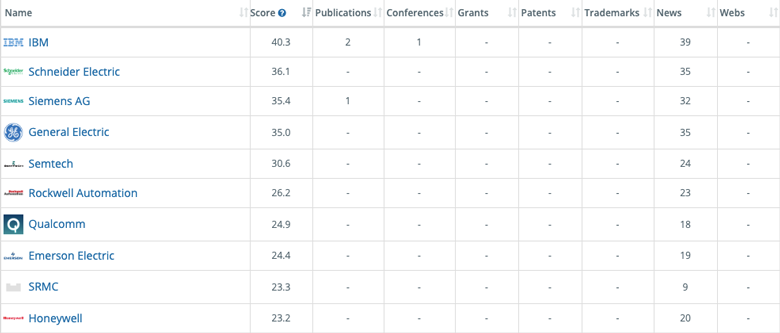
- Top 5 organizations worldwide using IoT for Water Management
Now, this is interesting. As we can see in the graph below, the top 5 organizations worldwide innovating in this topic all follow the same trend. Besides IBM, which explored in an earlier stage this technology, all of them entered the topic around 2015, as we can see by the number of records issued in 2016, and increased their innovative efforts by the years.
We will definitely see how this trend keeps growing in 2019.

2. Self-cleaning filters for Industrial Water Treatment
Self-cleaning filters integrate a set of screens to provide a balance of strength, filtering capacity and fine filtration. When sediment builds up on the inside of the filter, a self-cleaning mechanism of small nozzles is engaged to allow the filter cake to exit the filter in a concentrated stream.
- State-of-the-Art self-cleaning filters
Considering the aggregated set of data Linknovate has collected since 2010 for self-cleaning topics to be applied in water management, we can see that is a technology still in an early stage, as the graphs below show.
A 60% of the organizations working on this niche are academical (universities and research centers), and, also, more than 60% of the data comes from academical sources too (scientific publications, conference proceedings, and research grants).

- Top 10 Organizations Worldwide innovating in self-cleaning filters for Water Treatment
Although for the aggregated set of data we can see there is a prevalence of academic organizations, when it comes to the top 10 most active organizations in the topic the balance is reversed: and 70% are enterprises and a 30% are Universities.
It is interesting to see there are interesting actors from west and middle Asia, which are highly active in this topic.
Purdue University has received a highly relevant grant from the NSF to develop a self-cleaning microfiltration membrane system for water purification. They explore piezoelectric membranes to solve membrane fouling problems in filtration processes.
King Fahd University has three applied patents, exploring superhydrophobic self-cleaning surfaces and methods of coating. They come out of a research made on mechanically bendable superhydrophobic steel surfaces with self-cleaning and corrosion-resistant properties.
Finally, Israeli Amiad has developed innovative water-treatment technologies based on automated filtration systems, mainly aimed at metallurgical plants.
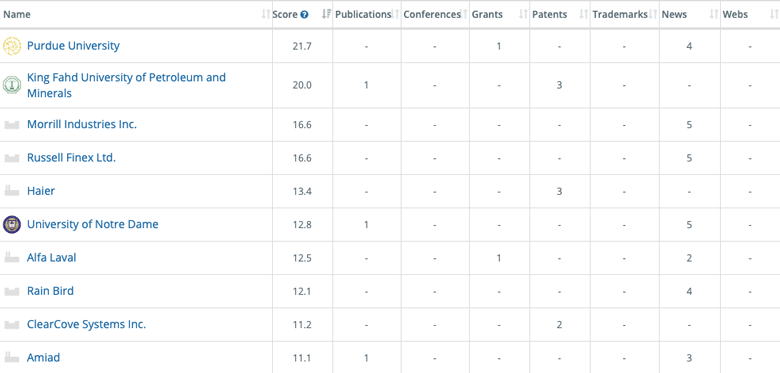
- Trends in self-cleaning filters for Water Treatment
As we can see in the graph below, main trends in self-cleaning filters for water treatment have to do with chemical treatments or with metal wastewater.
Regarding metal wastewater, research is being made to clean metal wastes in mining processes.

3. Water desalination for Chemical & Plastics Industries
Researchers and scientists from all over the world work on improving the affordability and efficiency on saltwater purification, as potable-water scarcity increases and developing regions like Africa and the Middle East are expected to demand an ever-growing number of these plants.
Water desalination is an industrial process that requires huge volumes of chemicals and energy. Hence, researchers are focused on developing innovative and eco-friendly desalination processes and machinery for long-term usage at reduced costs and environmental impact.
- State-of-the-Art of Wastewater Desalination
When looking at the Data Analytics Linknovate has generated for this topic, we can see that the activity peaked in 2015 and it has been decreasing since then. However, in this case the decrease of activity does not mean that the research resulted in disappointing results. More on the contrary, it means that it is a technology in the turning point of reaching the market.
As we can see on the graphs below, the most active organizations belong to Academia, which usually means a lower TRL. But, since the topic is getting closer to market and more companies and enterprises start to be active in this field, it usually comes with a decrease of the aggregated number of records but an increase on the number (or percentage) of patents, trademarks, and news (that talk about VC deals and startup acquisitions).

- Top 10 Organizations Worldwide desalinating water for the Chemical and Plastic industries
As we can see in the graph above, most of the organizations working on this topic belong to Academia (73%). However, when looking at the top 10 organizations of Linknovate’s ranking, eight are companies (corporations and SMEs), and only two are universities.
The MIT is one of the most active organizations in this topic, and have issued different scientific research and patent applications. Primarily, they explore desalinization via ion concentration polarization, and they also look into reverse osmosis.
As for Sylvan Source, they have recently applied for a patent in industrial water purification and desalination that uses alkaline hydroxides.
Finally, other company that has interesting research in water desalination is Mitsubishi. They are the organizations with more patent applications on the subject: 16 since 2010. Their line of research is aimed at power generation plants in which the used wastewater is treated and desalinated to separate it into regenerated water and concentrated water.
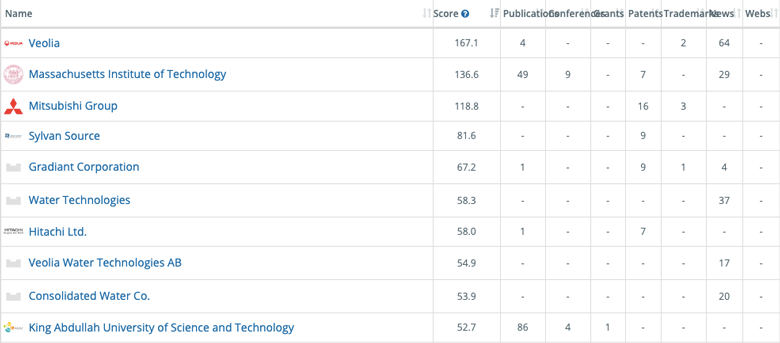
- Evolution of the organization prevalence in wastewater desalination
This graph below seems to confirm the hypothesis presented in the first section (state of the art). As we can see, Universities clearly dominated the activity in the topic until 2017, where there was a shift in the trend. From 2018, SMEs started to enter and dominate the topic (as well as corporations, with a lower intensity) and, already in 2019, are the most active organizations in wastewater desalination.
This means that the technology is reaching the market.
